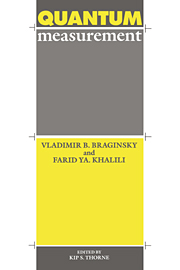Book contents
- Frontmatter
- Contents
- Dedication
- Editor's Foreword
- Notation
- Chapter I Historical introduction: photons and measurements using photons
- Chapter II The main principles of quantum mechanics
- Chapter III Indirect measurements
- Chapter IV Quantum nondemolition measurements
- Chapter V Linear measurements
- Chapter VI Continuous linear measurements
- Chapter VII Nonlinear systems for continuous measurements
- Chapter VIII Detection of classical forces
- Chapter IX Energetic quantum limitations
- Chapter X Devices for measuring small mechanical displacements
- Chapter XI Quantum nondemolition measurements of a resonator's energy
- Chapter XII Nonclassical states of electromagnetic waves as tools for quantum measurements
- Conclusion
- References
- Subject Index
Conclusion
Published online by Cambridge University Press: 15 December 2009
- Frontmatter
- Contents
- Dedication
- Editor's Foreword
- Notation
- Chapter I Historical introduction: photons and measurements using photons
- Chapter II The main principles of quantum mechanics
- Chapter III Indirect measurements
- Chapter IV Quantum nondemolition measurements
- Chapter V Linear measurements
- Chapter VI Continuous linear measurements
- Chapter VII Nonlinear systems for continuous measurements
- Chapter VIII Detection of classical forces
- Chapter IX Energetic quantum limitations
- Chapter X Devices for measuring small mechanical displacements
- Chapter XI Quantum nondemolition measurements of a resonator's energy
- Chapter XII Nonclassical states of electromagnetic waves as tools for quantum measurements
- Conclusion
- References
- Subject Index
Summary
The background for this book was a shift of interest among experimental physicists that began approximately 20 years ago. The shift was from quantum measurements on large ensembles of microscopic quantum objects, to experiments of very high precision on single, macroscopic objects. This shift was accompanied by developments in the “culture” of such measurements and the invention and elaboration of new experimental methods. In parallel with these experimental developments, there was a noticeable increase of theoretical interest in the foundations and interpretation of quantum theory, and even in attempts to revise its foundational principles. Although these efforts have not produced any significant changes in the fundamental structure of quantum theory, they have revealed a rather large number of “blank spots” and unsolved problems, to which the founders of quantum physics had paid no attention. A reasonable number of the blank spots have been filled in during the past decade.
The reader has probably noticed that this book can be divided into two parts. In the first (chapters I―VII and XI), the authors have tried to present the modern approach to the quantum theory of measurement. This part can be regarded as a tutorial appendix to textbooks for advanced undergraduate or graduate-level courses in quantum mechanics, where little attention is usually paid to measurement theory.
- Type
- Chapter
- Information
- Quantum Measurement , pp. 186 - 187Publisher: Cambridge University PressPrint publication year: 1992



